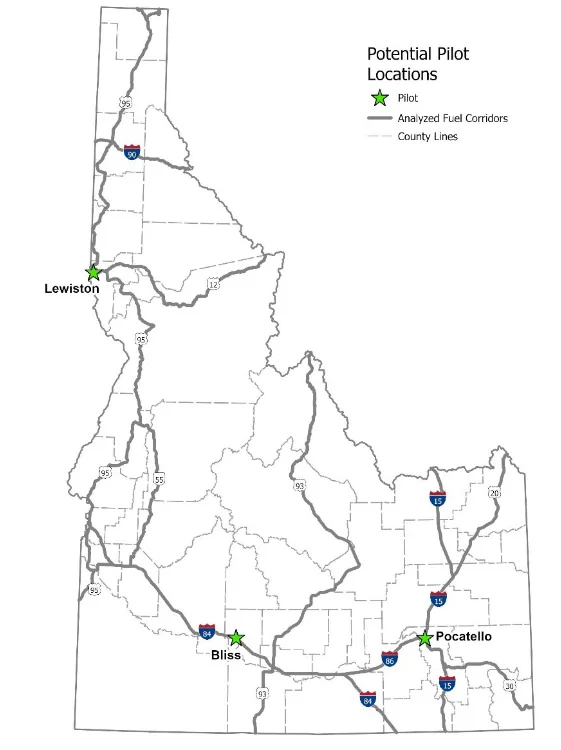The State of Idaho has made progress on its FY2024 NEVI Plan since the Baseline Plan was approved last year. Several new federal guidelines have been released that impact Idaho’s EV charging infrastructure planning.
The State of Idaho’s vision is to effectively deploy universal and publicly available EV charging infrastructure along Idaho’s major travel corridors over a multiyear time frame at intervals that provide drivers the confidence to travel throughout the state while meeting community and economic needs. This comprehensive planning process ensures that the state coordinates and synchronizes actions to support EV infrastructure.
To progress on this vision, Idaho will advance two pilot locations. The goal of advancing these two pilot locations is to gain insight on building EV infrastructure and in administering the NEVI Program effectively. The IAWG has identified three potential locations (with the intent of advancing two of them). Figure 10 indicates the proposed pilot locations, and the final locations to advance will be determined by late 2023.

These pilot site locations were identified based on preliminary findings of Idaho’s SFAS. These sites were areas of interest during the previous rounds of public input, they serve gaps along the interstates and US-95, and Lewiston and Pocatello serve tribal communities and they all serve disadvantaged communities. The SFAS is meant to inform and document the siting selection process and results and is expected to be completed by the end of 2023.
| Table 1. Criteria Considered in SFAS | |
|---|---|
| Criteria | Scoring Methodology |
| Disadvantaged Community | Potential station locations that lie within a Justice40 identified EV disadvantaged community will score the highest. Stations nearby will receive a medium score. Stations not adjacent will receive no score. |
| Tribal Lands | Potential station locations that lie within a Tribal community will score the highest. Stations nearby will receive a medium score. Stations not adjacent will receive no score. |
| Area of Interest | Potential station locations that are within a community that indicated interest for an EV charger in the Year 1 plan will receive a score. Stations not within will receive no score. |
| Proximity to Electrical Substation | Potential station locations that are closer to an existing electrical substation will receive a higher score. Stations located further will score lower. |
| Low-Income Roadway Users | Potential station locations with a higher percentage of drivers with a household income of less than $40K will receive a higher score. Stations with a lower percentage will score lower |
| FEMA Risk Index | Potential station locations located within an area that FEMA assigned a high natural disaster risk will score lower. Stations with less disaster risk will score higher. |
| Adjacent Amenities | Potential station locations with a higher number of amenities within a 1-mile radius (for example, convenience stores, hotels, restrooms, etc.) will score higher. Stations with lower adjacent amenities will score lower. |
| Population | Potential station locations with a higher adjacent population will score higher. Stations with a lower adjacent population will score lower. |
| EV Registration | Potential station locations with a higher number of EVs registered in that jurisdiction will score higher. Stations with less registrations will score lower. |
| Adjacent Gas Stations | Potential station locations with a higher number of existing gas stations (max three) within a 1-mile radius will score higher. Stations with fewer existing gas stations will score lower. |
| Roadway Classification | Potential station locations on an interstate corridor will score higher. Stations on other AFCs will score lower. |
| Distance to NEVI-Compliant Stations | Potential station locations that are further away from an existing compliant station will score higher. Stations closer to existing compliant stations will score lower. |
| Distance to Non-NEVI-Compliant Stations | Potential station locations that are further away from an existing noncompliant station will score higher. Stations closer to existing noncompliant stations will score lower. |
| Connectivity Node | Potential station locations at the intersection of two AFCs will score the highest. Stations at the intersection of an AFC and a highway will receive a medium score. Stations not at and intersection of highways will receive the lowest score. |
| Average Daily Traffic Volume | Potential station locations with high adjacent traffic volumes will receive a higher score. Stations with a lower adjacent traffic volume will receive a lower score |
| Trip Length | Potential station locations with a higher percentage of drivers traveling 50 miles or greater “long-distance” will receive a higher score. Stations with a lower percentage of long-distance travelers will score lower. |
Idaho conducted extensive public outreach efforts to engage communities on the NEVI Program. This included seven in-person public meetings across the state, social media outreach, and an upcoming survey to gather feedback on potential site locations and prioritization criteria. Valuable insights were received from the public to help shape the program.
Idaho also held targeted stakeholder outreach meetings with key groups like Idaho tribes, utilities, and industry associations. This helped obtain technical input to inform the NEVI rollout. The Shoshone-Bannock Tribe in particular expressed interest in hosting potential EV charging sites.
Idaho is now working to complete the SFAS by December 2023 to identify recommended site locations along Alternative Fuel Corridors. Two pilot sites will be selected through an RFP process later this year to test the site development process.